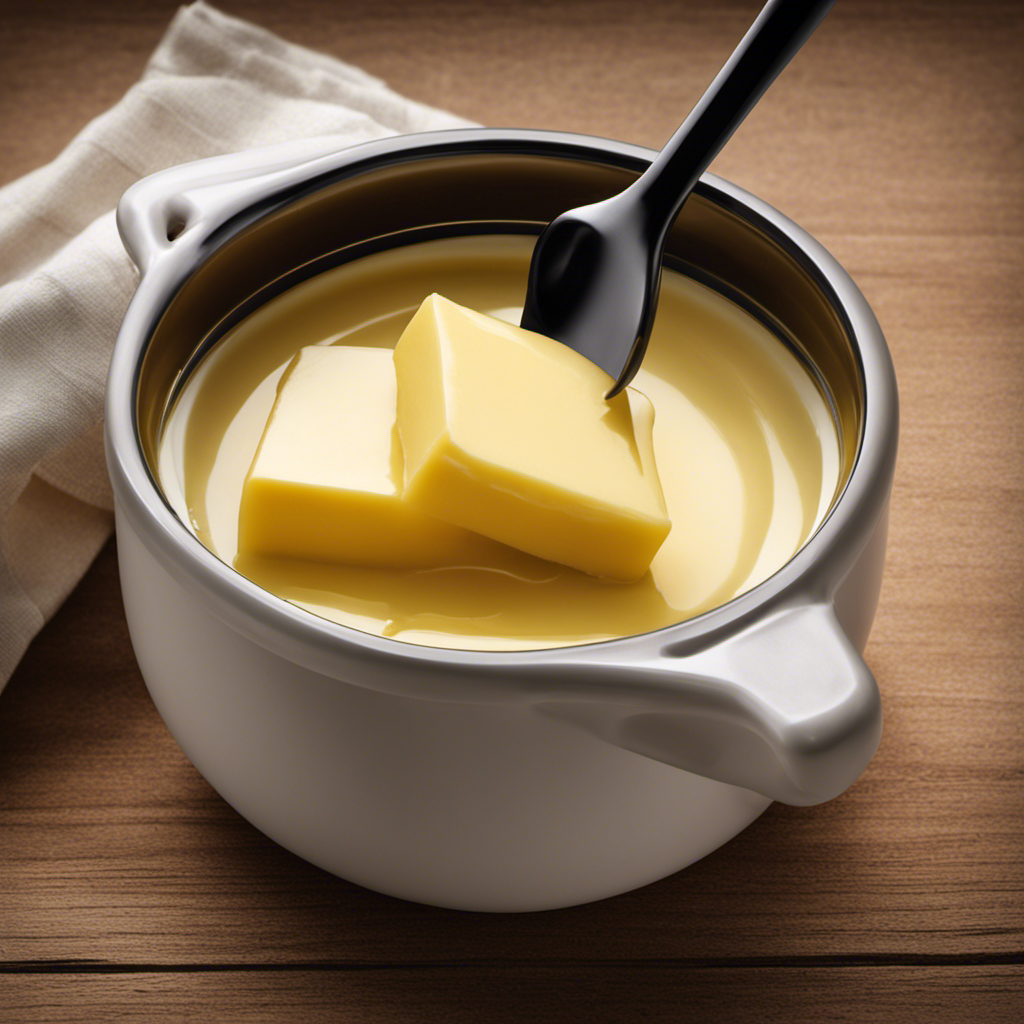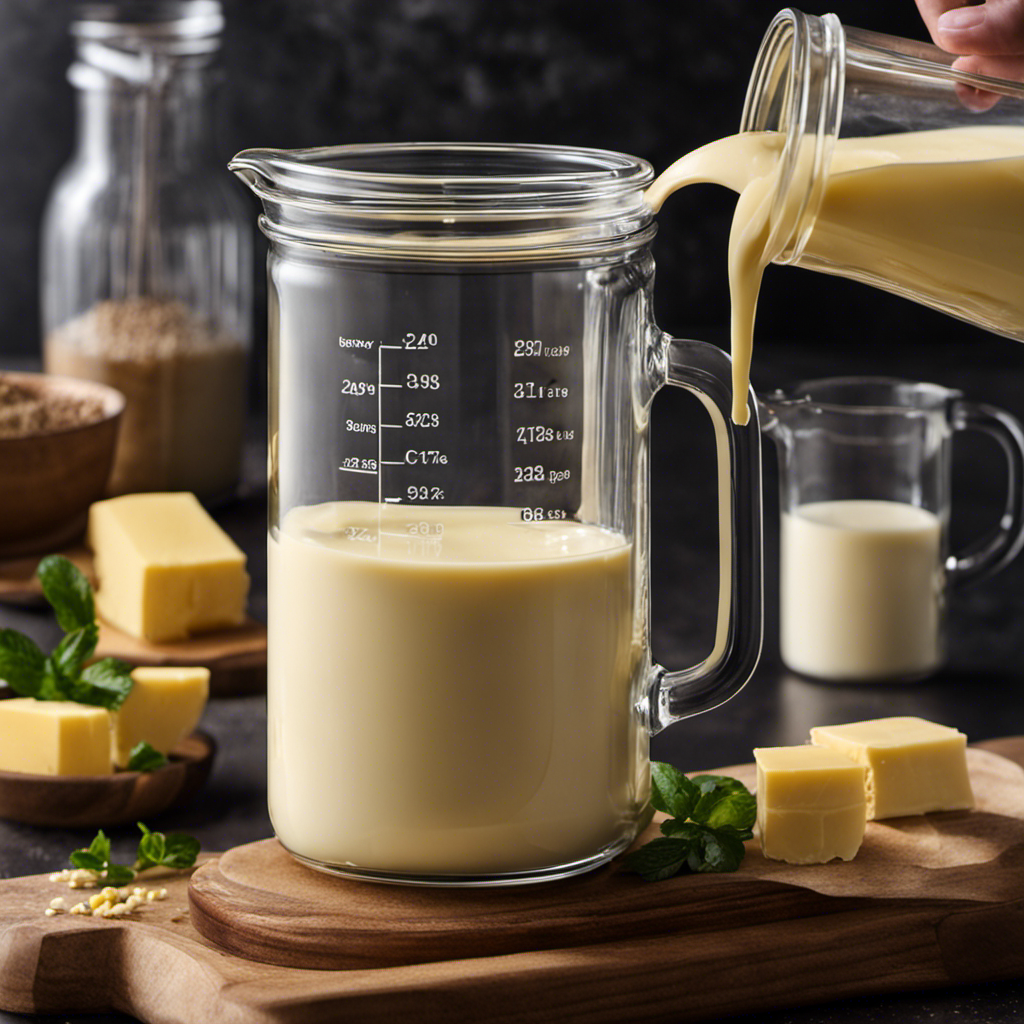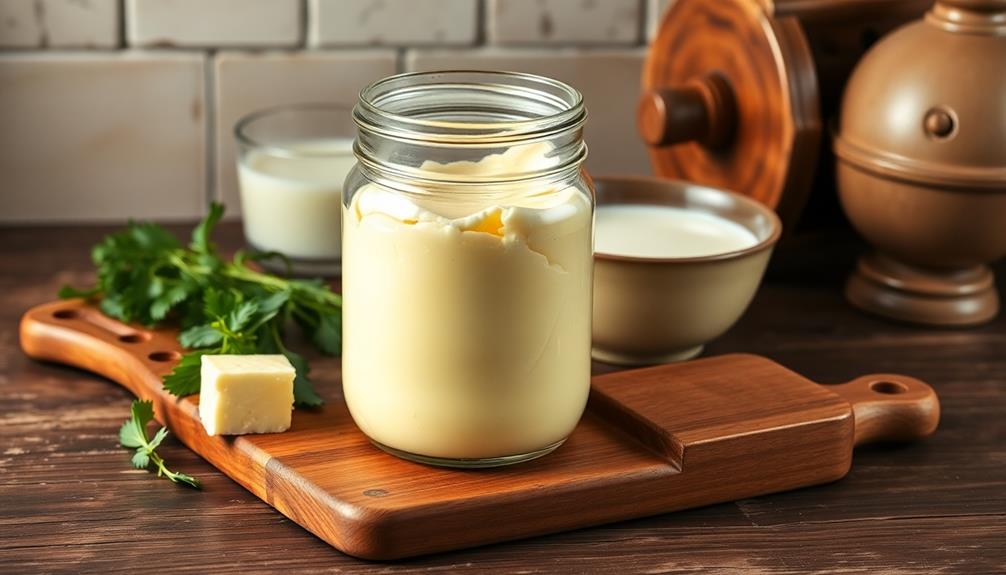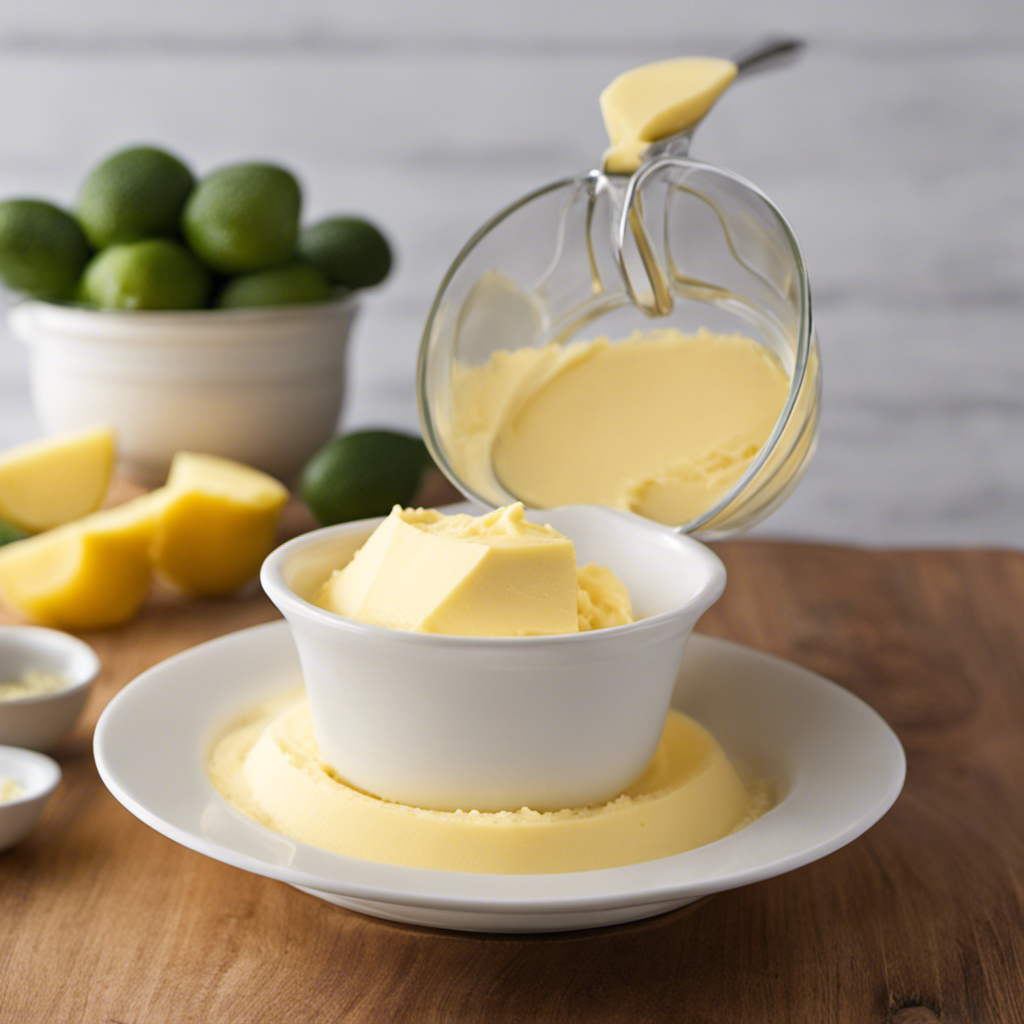Were you aware that swapping out oil for butter can significantly alter the flavor and consistency of your baked items? Indeed, opting for butter rather than oil in your recipes can impart a creamy and indulgent taste that’s quite tempting.
If you’re wondering how much butter to substitute for 1/2 cup of oil, you’ve come to the right place. In this article, I will share with you the perfect ratio, factors to consider, and tips for successfully using butter as a substitute for oil in your recipes.
So let’s get started!
Key Takeaways
- Use a 1:1 ratio to substitute 1/2 cup of oil with butter.
- Soften the butter before measuring to ensure accurate substitution.
- Take into account the smoke point differences between butter and oil.
- Consider the texture and flavor changes when using butter instead of oil.
Butter-To-Oil Substitution Ratio
To substitute 1/2 cup oil with butter, you’ll need to use a 1:1 ratio. When making this substitution, there are a few factors to consider to ensure success in your recipe.
First, consider the flavor profile of your dish. Butter adds a rich, creamy taste, so it works best in recipes where that flavor is desired.
Additionally, butter has a lower smoke point than oil, so if you’re cooking at high temperatures, it may not be the best choice.
Another important factor is the texture. Butter is solid at room temperature, while oil is liquid, so keep in mind that the final texture of your dish might be slightly different when using butter.
To make a successful substitution, make sure to soften the butter before measuring it out, as it needs to be in a similar state as the oil.
Lastly, be aware that butter contains water, so you may need to adjust the other liquid ingredients in your recipe to account for this.
Factors to Consider When Substituting Butter for Oil
When substituting butter for oil in recipes, there are several key factors to consider.
First, it is important to take into account the smoke point differences between the two. Butter has a lower smoke point than most cooking oils, which means it may burn at higher temperatures.
Second, texture and flavor changes should be considered. Butter adds richness and a distinct flavor to dishes, whereas oil tends to have a more neutral taste.
Lastly, it is crucial to be mindful of measurement conversion considerations, as the volume and weight of butter and oil may vary.
Smoke Point Differences
The smoke point of butter is lower than that of oil, so it’s important to consider this when substituting. When cooking at high temperatures, such as frying or sautéing, butter may burn and release harmful compounds due to its lower smoke point. To illustrate the difference between the smoke points of butter and oil, consider the following table:
| Substance | Smoke Point (°F) |
|---|---|
| Butter | 350 |
| Olive oil | 410 |
| Canola oil | 400 |
As we can see, butter has a significantly lower smoke point compared to both olive oil and canola oil. This has important implications for health considerations, as burning butter can produce compounds that have been linked to negative health effects. Therefore, when substituting butter for oil in high heat cooking, it is crucial to choose an oil with a higher smoke point to ensure the safety of the dish. In addition to smoke point, texture and flavor changes are also important factors to consider when substituting butter for oil.
Texture and Flavor Changes
Cooking with butter instead of oil can result in different texture and flavor profiles in your dishes. When using butter, the following changes may occur:
-
Texture changes: Butter has a higher fat content than oil, which can result in a richer and creamier texture in your dishes. It can also add a slight crispness when used for frying or sautéing.
-
Flavor modifications: Butter has a distinct and savory flavor that can enhance the taste of your dishes. It adds a rich and buttery taste that can complement a variety of ingredients.
-
Enhanced aroma: The aroma of butter can be more pronounced compared to oil, adding a delicious scent to your cooking.
-
Browning effect: Butter has milk solids that can brown when cooked, giving your dishes a golden color and adding depth of flavor.
-
Reduced shelf life: Butter has a lower smoke point than most oils, which means it can burn more easily. This can affect the overall flavor and quality of your dishes if not used correctly.
Measurement Conversion Considerations
To accurately convert your measurements, you should be mindful of the different units used in recipes. It’s important to ensure measurement accuracy to achieve the desired outcome in your dish. When substituting butter for oil, it’s crucial to consider both measurement and health considerations. Here’s a handy table to help you convert 1/2 cup of oil to butter:
| Oil | Butter |
|---|---|
| 1/2 cup | 1/2 cup + 1 tablespoon |
| 1/4 cup | 1/4 cup + 2 tablespoons |
| 2 tablespoons | 2 tablespoons |
| 1 tablespoon | 1 tablespoon |
| 1 teaspoon | 1/3 teaspoon |
It’s important to note that while butter adds richness and flavor to your recipe, it also contains more saturated fat compared to oil. So, when making substitutions, consider your health goals and dietary needs. Remember, accurate measurement conversions and mindful ingredient choices can help you achieve both taste and health in your cooking.
How to Convert 1/2 Cup Oil to Butter
When substituting butter for oil in recipes, it’s important to understand the butter-to-oil conversion ratio. This ratio determines how much butter should be used to replace a specific amount of oil.
Additionally, it’s crucial to consider the cooking implications of this substitution, as butter and oil have different properties that can affect the texture and flavor of the final dish.
To ensure a successful substitution, there are a few tips to keep in mind. One is adjusting the cooking temperature. Butter has a lower smoke point than most oils, so it’s important to lower the heat to prevent burning.
Another tip is using the right type of butter. Unsalted butter is recommended for most recipes, as it allows for better control of the overall flavor.
Butter-To-Oil Conversion Ratio
You should use a 1:1 ratio of butter to oil when substituting for 1/2 cup of oil. This ratio ensures that you maintain the right consistency and flavor in your recipe.
When comparing the taste of butter to oil, butter adds a rich and creamy flavor that enhances the overall taste of the dish. It provides a hint of sweetness and a satisfying mouthfeel.
However, it’s important to consider the health implications of using butter. Butter is high in saturated fat, which can increase the risk of heart disease when consumed in excess. Moderation is key when using butter as a substitute for oil.
Here are some key points to consider:
- Butter adds a rich and creamy flavor to your dishes.
- It provides a hint of sweetness and a satisfying mouthfeel.
- Butter is high in saturated fat, which can increase the risk of heart disease.
- Moderation is important when using butter as a substitute for oil.
- Consider using healthier alternatives like olive oil or avocado oil in your recipes.
Cooking Implications of Substitution
When it comes to substituting butter for oil in cooking, it’s important to consider the measurement accuracy and the health benefits.
Using the right amount of butter ensures that the recipe turns out as intended. The conversion ratio of 1:1 (1/2 cup butter for 1/2 cup oil) is commonly used, but it’s crucial to measure accurately. Too much or too little butter can affect the texture and taste of the dish.
Additionally, it’s worth noting that while butter adds a rich flavor to recipes, it also contains higher levels of saturated fat compared to most vegetable oils. Moderation is key when it comes to dietary choices.
For those looking to reduce saturated fat intake, using healthier oils like olive or coconut oil may be a better option.
Tips for Successful Substitution?
To ensure successful substitutions in your cooking, it’s important to accurately measure and consider the health benefits of different ingredients. Here are some tips for successful substitution and measurement conversion considerations:
- Use measuring cups and spoons for precise measurements.
- Understand the texture and flavor differences between ingredients.
- Consider the smoke point of oils when substituting for high-heat cooking.
- Be mindful of the nutritional content of different ingredients.
- Experiment and adjust ratios based on personal preference.
Now, let’s delve into the specific tips for using butter as a substitute for oil.
Tips for Using Butter as a Substitute for Oil
Using butter as a substitute for oil can add a rich and creamy flavor to your recipe. When comparing butter and oil, there are pros and cons to consider.
Butter adds a distinctive flavor and can enhance the texture of baked goods. However, it contains more saturated fat, which may not be ideal for those watching their cholesterol intake.
When baking with butter, it is important to ensure that the butter is softened before incorporating it into the recipe. This will help achieve a smooth and even mixture. Additionally, using unsalted butter allows for better control over the salt content in your recipe.
As we transition into the next section about adjusting recipes for butter substitution, it is crucial to understand the right amount of butter to substitute for a specific amount of oil in order to maintain the desired texture and consistency of your baked goods.
Adjusting Recipes for Butter Substitution
As we delve into adjusting recipes, it’s important to understand the proper ratio of butter to maintain the desired texture and consistency. When substituting butter for oil in baking, it’s crucial to follow a 1:1 ratio, meaning for every 1/2 cup of oil, you should use 1/2 cup of butter.
Here are some key points to consider when making this substitution:
- Butter adds richness and flavor to baked goods.
- Using butter instead of oil can result in a tender and moist texture.
- Butter contains natural fats that contribute to the overall structure of baked goods.
- Unlike oil, butter contains water content, which can affect the final outcome of the recipe.
- Butter has health benefits, such as providing essential fatty acids and fat-soluble vitamins.
Common Mistakes to Avoid When Substituting Butter for Oil
One common mistake when substituting butter for oil is not considering the impact of water content on the final outcome of the recipe. It is important to note that butter contains about 80% fat and 16% water, while oil is 100% fat. This difference in water content can affect the texture and moisture of the finished dish.
When substituting butter for oil, it is crucial to keep in mind the measurement accuracy. One cup of oil is not equal to one cup of butter, as the water content in butter can throw off the balance of the recipe. To ensure a successful substitution, it is recommended to use a ratio of 1:1. For every 1 cup of oil called for in the recipe, use 1 cup of melted butter.
Alternatively, you can explore other alternative substitutions such as applesauce or Greek yogurt, which have different water and fat content.
Frequently Asked Questions
Can I Use Margarine Instead of Butter When Substituting for Oil?
Using margarine instead of butter can be a healthier alternative. However, it may affect the taste of baked goods. It is important to consider the specific recipe and make adjustments accordingly.
Can I Substitute Coconut Oil for Butter When Converting 1/2 Cup Oil to Butter?
Personally, I find the debate between coconut oil and butter for baking intriguing. While coconut oil offers a unique flavor and potential health benefits, butter adds richness and a classic taste.
How Does Using Butter Instead of Oil Affect the Taste and Texture of Baked Goods?
Using butter instead of oil in baked goods can greatly impact the taste and texture. Butter adds richness and a creamy flavor, but it can also make the baked goods denser and more prone to spreading.
Are There Any Health Benefits to Using Butter Instead of Oil in Recipes?
Using butter instead of oil in recipes can have health benefits. Butter contains essential nutrients like vitamins A, D, and E, while oil lacks these. However, it’s important to note that butter is high in saturated fat, which can increase cholesterol levels.
Can I Use Ghee as a Substitute for Butter When Replacing Oil in a Recipe?
Yes, ghee can be used as a healthier alternative to butter when substituting oil in recipes. It retains the benefits of using butter in traditional recipes while also offering a rich and flavorful taste.
Conclusion
In conclusion, substituting butter for oil can be a delicious and effective way to enhance your recipes. By following the proper ratios and considering factors such as moisture content and flavor, you can achieve successful substitutions.
Remember that 1/2 cup of oil can be replaced with 1/2 cup plus 2 tablespoons of butter. One anecdote that illustrates the power of butter is when I substituted it for oil in a banana bread recipe. The result was a moist and flavorful bread that left my family asking for seconds.
So don’t be afraid to give butter a try in your next recipe!










